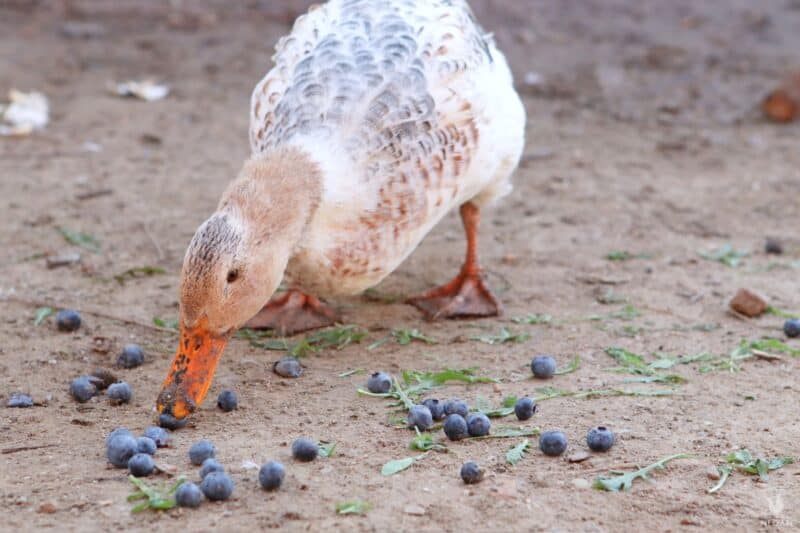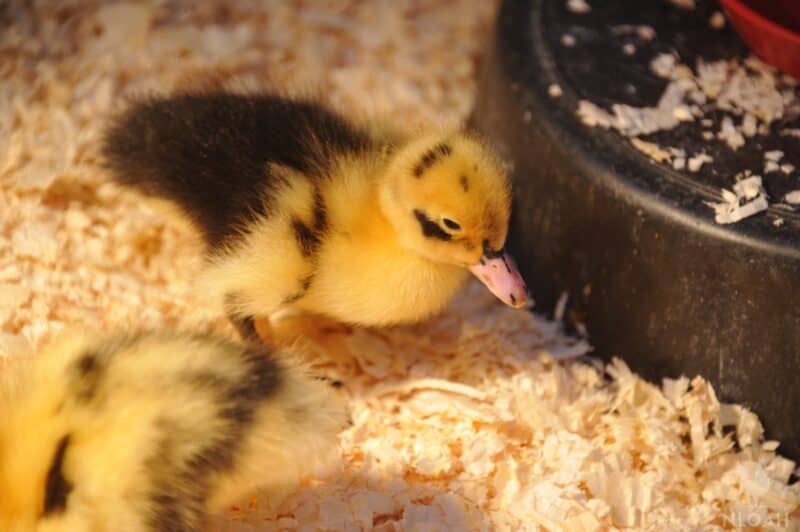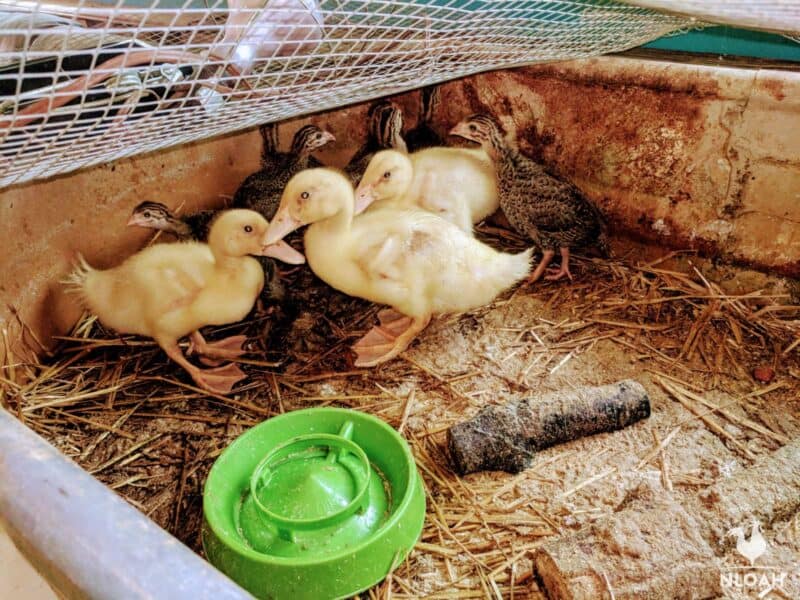No matter what you do in life, if you want to get good at it you’ve got to pick up a new vocabulary. Call it lingo, shop talk, vernacular, whatever. Sometimes it’s complex enough to border on a different language! Surprisingly, or maybe not, it’s the same with ducks.

If you’ve ever listened to two seasoned keepers have a conversation about their flocks, you probably tuned out pretty quickly. But it doesn’t have to be that way with just a little bit of practice and study.
If you don’t know your drakes from your mallards, “wing bars” from “angel wing” and a cloaca from a caruncle, you’re in the right place. As such, I’ve got a bunch of crucial duck terminology that you should familiarize yourself with if you want to raise ducks…
Poultry
A categorical term for domesticated avian livestock like chickens, geese, turkeys, emus, and ducks. Most useful in searching out sources of general expertise or guidance, e.g. a poultry veterinarian, a poultry guidebook, poultry suppliers.
Waterfowl
Another categorical term for birds that live their life partially we’re almost completely on the water, whether or not they are domesticated or wild. Ducks, geese, swans, etc.
Often helpful in tracking down specialty products like nutritionally optimized feed, supplements, medicines, etc.
Hen
A term for any female duck.
Pullet
A young female duck that is in her first year of laying. You might say it is her maiden year.
Drake
A term for any male duck.
Mallard
A specific species of wild duck, since domesticated as a separate strain, and the progenitors of nearly all other domestic breeds. Often confused by the ill-informed as a term for male ducks.

Duckling
Baby ducks that have not matured. When a duck hatches, it’s called a duckling until the time that it is fully developed physically and has its adult feathers, a process usually taking between 4 and 8 months depending on the breed.
Straight-Run
A term for an indeterminate group of ducklings, as they hatched. If you’re ordering ducklings that are straight-run, you don’t know how many will be males or females.
Sexed
A term used when the sex of a duckling or duck is known. Also used to refer to a group of ducklings being sold.
A sexed group of ducklings is either all males, all females, or a specific ratio as described by the seller. Note that this is difficult work even for experts much of the time, and mistakes happen!
Unsexed
The opposite of sexed, above. Refers to any duck of unknown sex, or a group of ducklings that haven’t been positively identified yet. Not always synonymous with straight run.
Autosexing
A term that refers to the ability to determine the sex of a duckling based on physical characteristics or coloration. Compared to chickens, there are very, very few autosexing duck breeds, with Welsh Harlequins being one of them.
Guardian
Or livestock guardian. A term for any animal that is kept with and among ducks that can help fend off predators. Might be a larger bird like a turkey, an alpaca, or even a well-trained livestock guardian dog.
Flock
Generic term referring to any group of ducks numbering three or more. Flocking refers to the tendency of ducks to gather together as a group. If you have multiple ducks, you have a flock of your own.
Raft
A synonym for flock, but only applies when ducks are floating out on the water. Any raft of ducks can be a flock, but a flock of ducks on land is not called a raft.
Plumage
A term that refers to the entirety of a duck’s feathers in terms of type, shape, color, texture, and so forth. A black duck might be said to have dark-colored plumage. A duck with frilly feathers has ruffled plumage, etc.
Contour Feathers
Contour feathers are the outermost feathers on a duck’s body that form the waterproof shell. These give a duck much of their shape, improve their maneuverability on the water and help them stay dry and insulated even in the coldest conditions.
Contour feathers are the ones that ducks spend a considerable amount of time preening and maintaining in order to preserve this quality. See preen gland and oil below.
Flight Feathers
These are the large feathers at the end of each wing that enable a duck to fly. Note that not all domestic ducks can fly, but if they can, you’ll need to clip or otherwise hobble these wing feathers to keep them grounded. They might take off, getting at least to adjacent homesteads otherwise!
Wing Bar
A distinctive band of brightly colored or contrasting feathers that’s revealed on a duck’s wing when it is spread. Thought to be used to signal to mates and make ducks more visible to one another. Some breeds have visible wing bars when their wings are folded and at rest.
Molt
A process by which a duck will shed its feathers and replace them with new ones in order to refresh them or change colors. Most ducks molt at different times throughout the year and for different reasons, be it migration, mating, or other purposes.
Angel Wing
An illness and deformity that affects ducks, typically resulting from major nutritional imbalances during their early, developmental life. Results in the wing being twisted, splayed, and held away from the body. Makes affected ducks completely unable to fly and more vulnerable to weather.
Down
The earliest, soft, and fuzzy feathers that ducklings are born with. Also refers to the innermost, finest feathers that serve as the insulating layer to keep adult ducks warm. Ducklings are said to lose their down as their adult feathers grow in.
Preen
Grooming behavior where a duck tends to its feathers, cleaning them, smoothing them out, and applying preen oil with its bill.
Preen Gland
A special gland, located near the base of a duck’s tail, that secretes preen oil, necessary for waterproofing and cleaning a duck’s feathers.
Bill
A duck’s beak.
Bean / Nail
This is the vertical bump or protrusion at the end of a duck’s bill.
Egg Tooth
A small, pointed protrusion present only on the bills of ducklings. They use this structure to help them break through the walls of the egg and hatch. It falls off and is gone in just a couple of days after hatching.
Web/Webbing
The fleshy membrane between the toes of ducks. Dramatically improves their speed and maneuverability when swimming in the water.
Vent
This is the posterior opening in a duck’s body through which waste products and eggs pass, and also through which mating occurs.
Pasting / Pasty Vent
Pasting of the vent occurs when a duck has diarrhea that builds up and closes off the vent, a condition known as pasty vent. Commonly afflicts ducklings but can also strike adult ducks. Must be remediated quickly or else the backup of feces or eggs can result in lethal infection.
Cloaca
The combined opening of the urinary, digestive, and sexual organ tracts located just inside the vent. Ducks have one opening that basically does it all!
Oviduct
The duct through which a hen’s eggs will pass. Terminates in the cloaca and deposits through the vent.
Egg Bound
A condition where a duck’s egg gets stuck in the oviduct or cloaca. Sometimes results from a physical impairment, an oversized egg, or a nutritional imbalance that causes an eggshell to collapse and clog things up. Must be dealt with immediately if detected or else it is fatal for the afflicted hen.
Caruncle
Red, fleshy, turkey-like growths that grow on the faces of Muscovy ducks. Bright red and large on males, somewhat smaller, smoother, and more subdued on females. Notably, caruncles will also appear on Muscovies anywhere they are injured and heal.
Hatchery
Any facility where ducks are raised and their eggs are tended to for subsequent hatching. Usually refers to laboratories or commercial institutions.
Incubator
A device, typically electric, that holds duck eggs at a precisely controlled humidity and temperature level to enable embryo development.

Brooder
A container, box, device, or designated space that holds ducklings and keeps them warm, safe, and in place. Often referred to as a brooder box.
Clutch
A group of duck eggs.
Brooding
A term describing what a mother duck does when she is sitting on and incubating a clutch of eggs.
Broody
Describes the behavior of a female duck that is intent on sitting on and hatching a clutch of eggs. Although most domestic ducks aren’t particularly broody, some are more prone to going broody than others.
This is problematic if you want eggs because she’ll stop laying, for one, and also get aggressive and defensive of her nest and eggs.
Pip/Pipping
What baby ducks do when they first crack the shell in order to break through it. Pipping proceeds to full hatching.
Pecking Order
Not just a figure of speech, this describes a very real social hierarchy in a flock of ducks.
Dominant males and preferred females are at the top while defeated males and lesser females are near the bottom. Influences everything from sleeping position in a group to access to food and mates.
Mating Display
Courtship behavior that drakes engage in to woo hens. However, if a female doesn’t submit, the male will typically copulate with her by force. Duck mating can be pretty violent and disturbing, FYI.
Free Range
A term describing ducks or other livestock that are allowed to roam, explore, and nibble across a large area outside of a run or other enclosure. Also applied to the products of any such animals, including duck eggs and meat.
Free-ranging is a practice, and one that is very beneficial for ducks overall though it does make them more vulnerable to predators.
Duckweed
Colloquial and common name for Lemna spp., a free-floating aquatic plant that is often found in ponds and lakes. Greatly loved by ducks as an easily-digestible and nutritious food source, hence the name. Cultivating or harvesting duckweed is a great way to give your flock varied nutrition and add some interest to their menu.
Feed
Feed is just processed or natural dry food for ducks. Typically takes the form of pellets or small kibble.
Can be generically used to refer to anything that is deliberately sourced and fed to ducks, as opposed to plants, insects, and other things that they might find out in the wild or on your property, referred to as forage.
Starter Feed
Feed that is specially formulated for the intense nutritional demands of growing ducklings. Contains extra protein and is optimized with the vitamins and minerals they need in order to thrive and develop properly. Absolutely a must-have if you want to raise ducklings worry-free.
Layer Feed
This is duck feed that is optimized for the nutritional needs of laying hens, meaning females that are currently laying eggs.
These hard-working girls need lots of extra protein, calcium, and minerals in order to keep up their energy and also to form strong eggshells that will pass through the oviduct safely and protect the embryos developing inside.
Crumbles
Refers to feed, usually pellets, for adult ducks that are processed or crushed into smaller, easy-to-swallow bites. This reduces the likelihood of choking and digestive tract impaction, and also makes it easier for ducks to digest.
Grit
Sand, small stones, pebbles, and other hard, natural materials that ducks will deliberately swallow in order to help them digest food. These particles take up residence in the gizzard. Can also be supplied as a supplement to their usual diet.
Gizzard
A muscular pouch that helps ducks digest food by grinding it up. Grit is stored here and assists in the process. The gizzard cannot work correctly without enough grit, so ducks must have access to it.
Duck Coop / Duck House
An outdoor shelter that keeps ducks safe from inclement weather, gives them a cozy place to rest and lay, and get in out of intense sunshine.
Unlike chicken coops, duck houses don’t need roosting bars because ducks typically sleep on the ground. Should be well-ventilated, have deep bedding inside, and provide at least four square feet of space for each adult duck.
Tom has lived and worked on farms and homesteads from the Carolinas to Kentucky and beyond. He is passionate about helping people prepare for tough times by embracing lifestyles of self-sufficiency.
